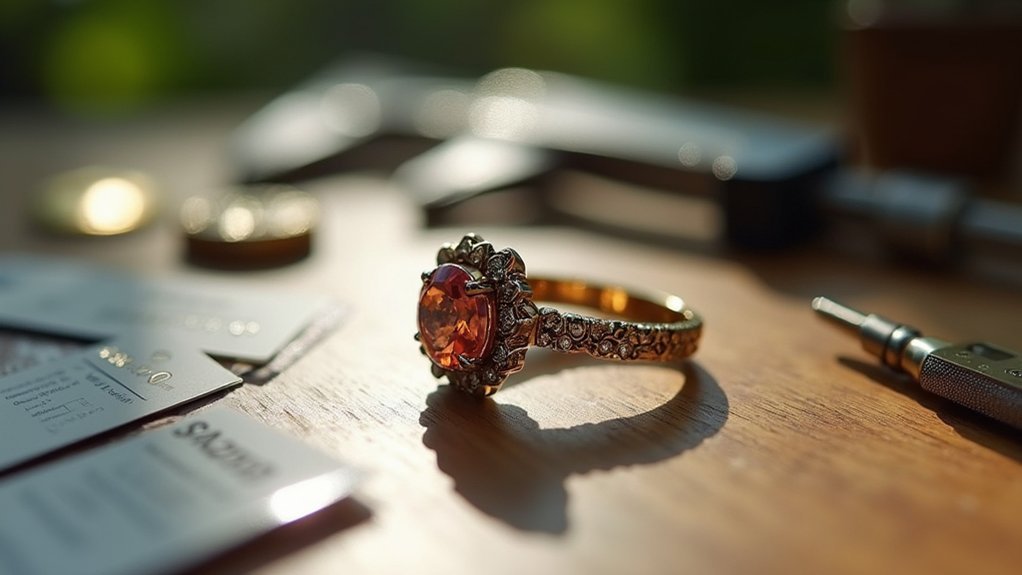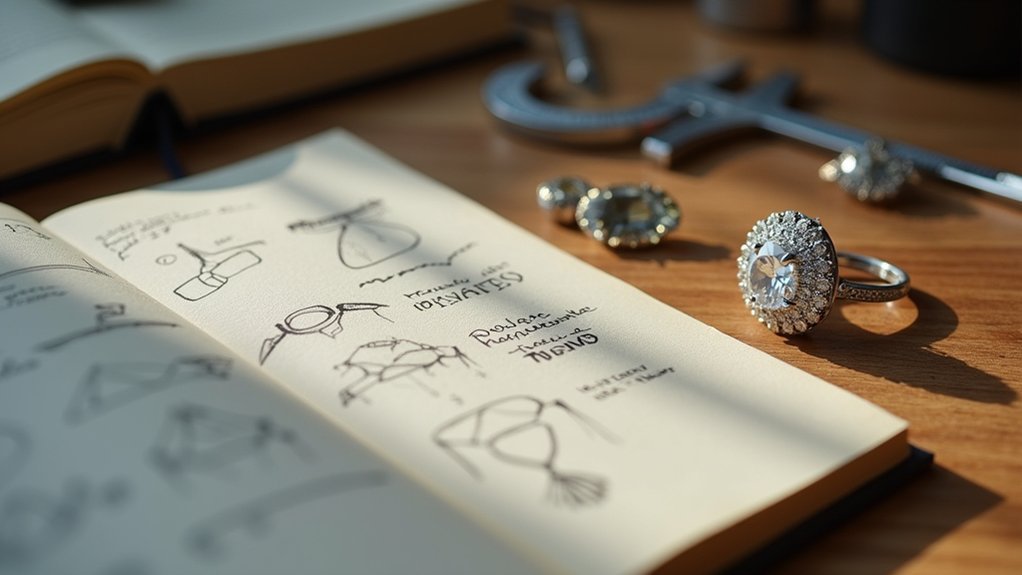You’ve probably experienced that uncomfortable moment when a client’s face drops after hearing your custom jewelry quote. The gap between their expectations and your pricing doesn’t have to derail every consultation. Smart jewelers know that successful pricing conversations aren’t about justifying costs—they’re about building value before numbers enter the discussion. The difference between losing a client and closing a sale often comes down to three critical mistakes most jewelers make during their initial consultation.
Understanding Material Costs and Market Fluctuations

When you’re planning a custom jewelry project, understanding material costs becomes essential since precious metals like gold and silver experience constant market fluctuations, with gold prices swinging between approximately $1,500 to $2,000 per ounce in recent years.
Gemstone prices vary dramatically—diamonds cost $1,500 to $20,000 per carat depending on cut and clarity, while sapphires range from $50 to $10,000 per carat.
You’ll find lab-created gemstones offer 20-40% savings compared to natural stones, making them budget-friendly alternatives.
Market conditions including demand trends, geopolitical factors, and economic indicators constantly affect jewelry pricing.
You must conduct regular price assessments to guarantee accurate budgeting for your custom jewelry projects and avoid unexpected cost overruns.
Calculating Labor and Craftsmanship Value
You’ll need to establish a clear hourly rate by dividing your annual overhead costs by the number of profitable hours you can realistically work each year.
Track every minute you spend on each project, including design time, client consultations, and any revisions or adjustments you make during the creation process.
This thorough time tracking guarantees you’re compensated fairly for all aspects of your craftsmanship, not just the hands-on fabrication work.
Hourly Rate Determination
Since your hourly rate forms the foundation of profitable custom jewelry pricing, you’ll need to calculate it methodically by dividing your total annual overhead costs by the number of billable hours you expect to work each year.
Your pricing strategies should reflect the complexity and skill level required for each piece, as master jewelers command higher rates for their expertise.
Don’t forget to account for all time and effort involved—including design consultations, administrative tasks, and client communications—not just bench work.
A proven approach combines 2.5 times your cost of materials with your hourly wage, plus 10% for overhead expenses.
Regularly reassess your rates to maintain profitability as operational costs and market conditions evolve.
Time Tracking Methods
How can you guarantee every minute of your craftsmanship translates into fair compensation? You’ll need robust time tracking methods that capture every aspect of your jewelry creation process.
Use dedicated apps or detailed spreadsheets to log time spent on design, fabrication, and administrative tasks for each piece. This data becomes the foundation of your pricing structure, ensuring you’re compensated for all labor invested.
Track time spent sourcing materials used, client consultations, and post-completion tasks like packaging and delivery. Many jewelry businesses underestimate these hidden hours, resulting in underpriced pieces.
Your tracking system should distinguish between different types of work, allowing you to analyze efficiency patterns and identify bottlenecks. Regular review of this data helps you refine production processes and maintain competitive yet profitable hourly rates.
Researching Competitor Pricing and Market Standards

You’ll need to systematically analyze your competitors’ pricing structures to understand where your custom jewelry fits in the current market landscape.
Start by examining similar handmade pieces that match your materials, design complexity, and craftsmanship level to establish realistic price benchmarks.
This competitive analysis becomes your foundation for setting prices that attract customers while maintaining profitability in the $500 to $2,000 custom jewelry market range.
Market Analysis Methods
Before setting prices for your custom jewelry pieces, you must understand where your work fits within the current market landscape. Effective market analysis starts with examining similar handmade jewelry businesses to understand their pricing structures and product offerings.
You’ll want to utilize tools like The Craft Calculator App to establish baseline estimates based on materials and labor costs. Monitor industry trends closely, especially fluctuations in precious metals and gemstones that directly impact your material expenses.
Engage actively with customer feedback to gauge perceived value and guarantee your pricing aligns with market expectations. Compare pricing across different sales channels while maintaining MSRP consistency.
Remember that wholesale pricing typically requires cutting retail prices in half, so factor this into your overall pricing strategy.
Competitive Price Benchmarking
Once you’ve established your foundational market understanding, competitive price benchmarking becomes your strategic compass for positioning custom jewelry pieces effectively within the marketplace.
You’ll need to analyze at least five competitors’ pricing structures to determine accurate market value baselines for your offerings. Track material costs and labor rates through industry forums while observing pricing trends at local trade shows and craft fairs. This thorough approach guarantees your pricing strategy reflects current jewelry industry standards.
Remember to update your benchmarks regularly as material costs and market demand fluctuate.
While competitor data provides essential guidelines, you can justify pricing deviations when your unique value proposition warrants premium positioning. This strategic balance maintains profitability while keeping you competitively aligned.
Establishing Clear Budget Parameters With Clients
When setting budget parameters with custom jewelry clients, establishing realistic expectations becomes the foundation of a successful project.
You’ll need to communicate that custom pieces typically range from $500 to $2,000, helping your target audience understand pricing from the start.
Explain how high-quality materials like gold and platinum greatly impact costs due to fluctuating per-gram prices.
Premium metals like gold and platinum fluctuate daily, making material costs the largest variable in custom jewelry pricing.
Design complexity directly affects labor requirements and final pricing. Intricate, personalized pieces demand more skill and time than simpler designs.
Don’t forget to discuss hidden costs including design alterations, shipping, and insurance that can impact budgets.
Encourage clients to research materials and jewelers beforehand. This preparation helps them allocate sufficient funds for both custom designs and expert craftsmanship, ensuring realistic budgeting.
Identifying Hidden Costs and Additional Expenses

Beyond the initial quote you’ve received, several unexpected expenses can catch you off guard during your custom jewelry project. Understanding these hidden costs helps you budget accurately and avoid pricing surprises.
Design alterations represent the most common additional expenses in custom jewelry. Complex changes can greatly impact your final cost, especially if you request multiple revisions during the creation process.
| Cost Category | Potential Impact | Planning Tips |
|---|---|---|
| Design Changes | High – varies by complexity | Finalize design early |
| Shipping/Insurance | Medium – based on value/weight | Compare carrier options |
| Taxes/Duties | Medium – especially international | Research local regulations |
| Packaging/Services | Low to Medium | Ask about inclusions |
| Material Fluctuations | Variable | Lock in prices when possible |
You’ll want to discuss these potential additional expenses upfront with your jeweler to guarantee transparent pricing throughout your project.
Communicating Value Proposition During Consultations
Understanding all potential costs sets the foundation for successful pricing discussions, but your ability to communicate why custom jewelry justifies its investment determines whether clients move forward with their projects.
Mastering cost communication is essential, but articulating your jewelry’s unique value truly determines whether clients commit to their custom pieces.
When communicating value proposition during consultations, focus on what makes your work irreplaceable. Share stories about your craftsmanship process and the specialized techniques you’ll use to create unique pieces that reflect their personality. The most important thing isn’t just explaining costs—it’s helping clients envision their investment as an experience and future heirloom.
- Emphasize personalization: Highlight how custom pieces perfectly match their individual style versus mass-produced alternatives.
- Showcase superior quality: Demonstrate ethical sourcing and premium materials that justify pricing.
- Build emotional connection: Position their piece as a lasting legacy rather than simply a purchase.
This approach will naturally increase your pricing acceptance rates.
Building Trust Through Transparent Pricing Methods

Nothing builds client confidence faster than showing exactly how you arrive at your prices. When you implement transparent pricing methods, you’re demonstrating respect for your customers’ intelligence and financial investment.
Break down material costs, labor hours, and overhead expenses openly. This approach helps you sell your work more effectively because clients understand they’re paying for genuine value, not arbitrary markups.
Your jewelry brand gains credibility when customers see exactly where their money goes. High end clients especially appreciate this honesty—they’re making significant investments and want assurance they’re dealing with ethical professionals.
Studies show 70% of consumers prefer brands that openly discuss pricing. This transparency transforms potentially awkward price conversations into collaborative discussions about craftsmanship, materials, and design complexity.
Frequently Asked Questions
What Is the Formula for Pricing Handmade Jewelry?
You’ll calculate material costs plus labor costs, then multiply by 2-2.5 times for markup. Don’t forget to include your hourly rate based on annual overhead divided by productive working hours.
What Is the Profit Margin on Custom Jewelry?
You’ll typically see profit margins between 40% to 60% on custom jewelry. You can achieve higher margins than mass-produced pieces since customers pay premiums for personalized, unique designs and skilled craftsmanship.
What Pricing Strategy Is Commonly Used by Consultants Freelancers and Contractors?
You’ll find hourly rates are most commonly used by consultants, freelancers, and contractors, typically ranging from $50-300 per hour based on your experience and industry expertise level.
What Is a Good Markup for Jewelry?
You’ll want to use a 2 to 2.5 times markup for retail jewelry pricing. For wholesale, you’d typically markup materials by four times to guarantee you’re covering all costs and maintaining healthy profit margins.
In Summary
You’ll master custom jewelry pricing by understanding material costs, calculating fair labor values, and researching competitor standards. Set clear budget parameters upfront and don’t forget hidden expenses like shipping or alterations. Your transparent communication builds trust while showcasing your unique craftsmanship story. When you involve clients in budgeting decisions, you’re creating emotional connections that transform consultations into successful partnerships. This approach guarantees satisfied customers who appreciate both your artistry and honest business practices.





Leave a Reply